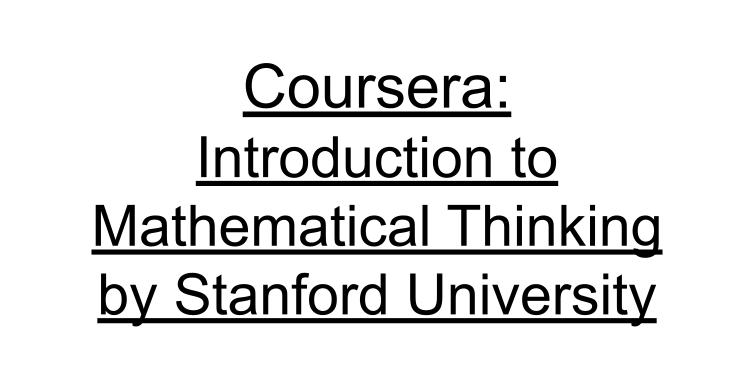続いて、Week 2 です。だんだん楽をするようになって、英語のままメモってます。時間があれば、日本語の解説交えたいなぁ。と思いながら。
講義自体は、YouTube で公開されてます。リンクがこちらにあるので、興味がある人はぜひ。
https://www.youtube.com/watch?v=LN7cCW1rSsI
※ あくまで素人が趣味で防備のノートとしてまとめているだけなので、解釈違い、数学的な厳密さの欠如についてはご容赦ください。
Lecture 3 – Implication
In mathematics, we frequently encounter expressions of the form, Φ implies Ψ.
Φ implies Ψ if the truth of Psi follows from the truth of Phi.
Implication has a truth part and a causation part. We are going to ignore the causation part and just focus on the truth part. We are going to give the truth part a name, the conditional or sometimes, the material conditional.
implication = conditional + causation
The truth of the conditional “Φ ⇒ Ψ” is defined in terms of the truth of Φ and Ψ.
ここで、Φ: N > 7, Ψ: N2 > 40 の時、Φ ⇒ Ψ は、true となる。
また、Φ: Julius caesar is dead, Ψ: π > 3 の時の時もまた、Φ ⇒ Ψ は、true となる。
In “Φ ⇒ Ψ”, we call Φ the antecedent and we call Ψ the consequent.
This is actually quite common in mathematics to extend the domain of definition of something so that it’s always defined.
Real implication means the truth of Ψ would follow from the truth of Φ.
We’re trying to extend implication to be defined in all cases where there’s no causation.
-> causation(因果関係) のない場合にまで、implication(論理包含) を拡張したい、ってことです。具体的には、下の真理値表の3〜4行目のことです。
| Φ | Ψ | Φ ⇒ Ψ |
|---|---|---|
| T | T | T |
| T | F | F |
| F | T | T |
| F | F | T |
It there were a genuine implication “Φ implies Ψ” and if that implication were true, then Ψ would have to be true if Φ were true. So we cannot have Φ true and Ψ false, if “Φ implies Ψ” is true. Hence if Φ is true and Ψ is false, we must have “Φ implies Ψ” false.
上の真理値表の3〜4行目を考えるに際して、直感的な結論は出せない。真である仮定から導き出される結論にしかそもそも興味がないため。
The reason you have no intuitions is that even though you’re used to dealing with implication you’ve never dealt with an implication where the antecedent was false. You’re only ever interested in drawing conclusions from true assumptions.
そして、この真理値表の2行目より、
“Φ does NOT implies Ψ” if: even though Φ is true, Ψ is nevertheless false. となり、
すなわち、
In all other circumstances, Φ ⇏ Ψ will be false.
とどのつまり、
In all other circumstances, Φ ⇒ Ψ will be true. となる。
まとめると、
The definition for a true antecedent is based on an analysis of the truth values of genuine implication. The definition for our false antecedents is based on a truth value analysis of the notion “does not imply“.
Lecture 4 – Equivalence
Two statements are said to be equivalent, or more fully, logically equivalent, if each implies the other. Equivalence is a central notion in mathematics.
In fact, equivalence is to logic as equations are to arithmetic and algebra.
「等式」が算術や代数にあるように、「同値」は論理のそれと言える。
The statements Φ, Ψ are said to be (logically) equivalent if each implies the other.
Biconditional: Φ ⇔ Ψ, it’s an abbreviation of (Φ ⇒ Ψ) ∧ (Ψ ⇒ Φ)
Φ ⇔ Ψ is true if Φ, Ψ are both true or both false.
One way to show that two statement Φ’ and Ψ’ are equivalent is to show they have the same truth tables.
For example: (Φ ∧ Ψ) ∨ (¬Φ) is equivalent to Φ ⇒ Ψ.
where:
- Φ’: (Φ ∧ Ψ) ∨ (¬Φ)
- Ψ’: Φ ⇒ Ψ
この場合、Φ’ と Ψ’ の真理値が同じであれば、同値ってことです。
ただし、次に留意すること。
I should mention that proving equivalence by means of truth tables is very unusual. It’s only of a special case of equivalence. In general, proving equivalence is really quite hard. You have to look at what the two statements mean and develop a proof based on their meaning.
The following all mean “Φ implies Ψ”
where:
Φ: antecedent
Ψ: consequent
- If Φ, then Ψ
- Φ is sufficient for Ψ
- Φ only if Ψ … NOT the same as ‘IF Ψ THEN Φ.’
- Ψ if Φ
- Ψ whenever Φ
- Ψ is necessary for Φ
“Φ is equivalent to Ψ” is itself equivalent to:
- Φ is necessary and sufficient for Ψ
- Φ if and only if Ψ (“if and only if” is usually abbreviated in “iff”)
まとめ
内容自体はそこまで難しくないですが、英語で正しく解釈しようとすると結構時間がかかります。
「P ならば Q」を英語で言い換えようと思うと、”if” や “when” または、”only if” それから “is necessary” 、”is sufficient” などなど、いろんな表現がありますね。
前回の “Logical combinators” と同様、数学の公式や理論よりも、如何に数学という「言語」を通して考えるかってとこに着眼してある内容です。
引き続き、後のモジュールも受講していきます。
それでは!



コメント